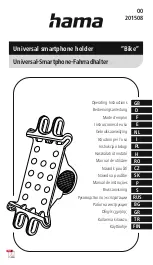
47
Milling safely
1.
Read the instructions
enclosed with the electrically
powered tool, accessories, and
bits.
2.
Keep your hands,
hair or clothing away from the
router bit.
3.
Remove keys or other
tools used to service the device
prior to commissioning. Make
sure the bit can rotate freely.
4.
Exclusively process
workpieces made of materials
suitable for machining with
hand-held routers (usually solid
wood, wooden materials). Make
sure they are free from metal
inclusions (e.g. nails).
5.
Do not switch on the
router if the bit is in contact
with the workpiece.
6.
The milling pro-
cess must always advance in
contrary to the bit’s direction of
rotation.
7.
Do not mill without a
suitable fence (longitudinal fen-
ce, transverse fence or starting
pin) to prevent rebounding. For
this purpose, also observe all
data in the operating manuals
of the fences intended for use.
8.
Particularly make
sure to work at the front and
rear during recess milling using
suitable fences and/or pressing
devices to minimize the risk of
rebounding.
Router bit safety
1.
Router bits are sharp
objects. Handle bits with care.
Do not drop bits and do not
hit them against hard objects.
Handle small bits with particu-
lar care. Put router bits back
into the packaging after having
used them.
2.
Do not exceed the
maximum speed (n.max), high-
lighted on the shaft, packaging
or manual. If stated, accura-
tely keep to the speed range.
Usually manufacturers state
recommended speeds.
3.
Use the router bit in
routers or router motors only.
Do not use drills and drill bits in
a router. Exclusively use router
bits with the material they have
been developed for. Do not use
router bits in metal or stone.
4.
Always keep to the
maximum permitted bit diame-
ters for the router motor used.
Your router manual contains
corresponding data. The router
table has been designed for
maximum bit diameters of 86
mm.
5.
Exclusively use sharp,
intact, and high-quality router
bits designed and approved for
high-speed, hand-held routers
and for manual feed. Unsuita-
ble, inadequate or blunt bits
pose a very high safety risk.
6.
Make sure that the
collet used matches the shaft
diameter of the router bit.
Clamp the bit as far into the
collet as possible, at minimum
¾ of the shaft length. Always
make sure the bit is positioned
securely.
7.
Keep router bits cle-
an. Regularly remove adhesive
or resin residue using a suitable
cleaning agent. Using PTFE
spray reduces a build up of
adhesive and resin. Do not use
PTFE on plastic.
8.
When using assem-
bled router bits on a spindle
make sure that the cutting ed-
ges have been installed with an
off set to absorb cutting impact.
9.
Note the instructions
on bit change in the user ma-
nual of your router motor.
10.
The router bit must
have been clamped so that
it cannot come loose during
operation. Carefully install the
router bit and make sure that
the clamping force grips the bit
shaft eff ectively as well as that
cutting edges cannot come into
contact with each other or with
clamping elements.
11.
We recommend re-
gularly checking the collet and
nut. A damaged, bent, or worn
collet and nut may cause vibra-
tions and/or damage the shaft.
Do not excessively tighten the
nut and collet.
12.
Do not mill too
deeply in a single step. Divide
the process into several steps,
keep the volume removed by
cutting low and consequently
reduce the forces applicable
from the side. Excessively deep
milling may stall the router.
13.
Immediately switch
off the router in the event of
unwanted vibrations and check
whether the router has been
correctly clamped in the centre.
14.
All attachment ele-
ments must be tightened using
the dedicated key and to the
tightening torque specifi ed by
the manufacturer.
15.
Extensions on keys or
tightening by using a hammer
are not permitted.
16.
Clamping screws
must be tightened as specifi ed
by the manufacturer. If there
are no instructions, the clam-
ping screws must be tightened
in sequence from the centre
towards the outside.
WARNING
!
WARNING
!
Summary of Contents for OFL1.0
Page 1: ...sauter OFL Betriebsanleitung Modelle OFL1 0 OFL2 0 OFL2 0 MINI OFL2 0 AD43 Deutsch Englishe ...
Page 28: ...28 17 Explosionszeichnung und Ersatzteilliste Abb 22 Explosionszeichnung OFL1 0 ...
Page 30: ...30 Abb 23 Explosionszeichnung OFL2 0 und OFL2 0 MINI Abb 24 Explosionszeichnung ADAP43 OFL 34 ...
Page 32: ...32 18 Skizze für den Frästisch Ausschnitt Abb 25 Erforderliche Einbaumaße am Frästisch ...
Page 33: ...sauter OFL User manual Models OFL1 0 OFL2 0 OFL2 0 MINI OFL2 0 AD43 ...
Page 60: ...60 17 Exploded view and spare parts list Fig 22 Exploded view of OFL1 0 ...
Page 62: ...62 Fig 23 Exploded view of OFL2 0 and OFL2 0 MINI Fig 24 Exploded view of ADAP43 OFL 34 ...
















































